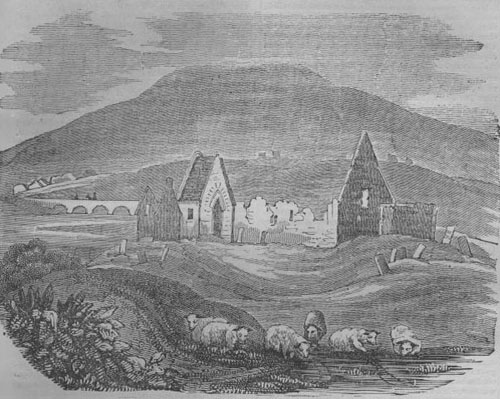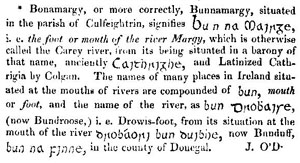Abbey of Bona-Marga (Bun-na-mairge), County Antrim
From The Dublin Penny Journal, Volume 1, Number 41, April 6, 1833

Along the extensive line of coast of the county of Antrim are scattered a considerable number of picturesque ruins, whose origin is frequently lost in fable, but whose rude and massive architecture evince their remote antiquity. Many of these were evidently intended for permanent castles of defence against the predatory invasions of the Scotch—some for the residence of the baronial chieftain—and others for temporary watch-towers. Amid this assemblage of gothic remains, the only monastic building on the coast is the abbey of Bona-marga (properly called Bona-margy [1]) of which we are now about to give some account, and which ranks among the latest of the monastic edifices erected in Ireland. This interesting remain is situated about half a mile from the town of Ballycastle, near the base of the mountain of Knoc-lade, i.e. the broad mountain, and is said to have been erected by Somarle [2] M'Donnal, commonly called Sorley Buy, or Yellow Sorley, in 1509, for Franciscans of the third order, or strict observance. We have given this date as that usually assigned for its foundation, but there must be some error in those particulars, as Sorley-Buy could hardly have been born in 1509, and if he were the founder, it must have been at a much later time: we incline, however, to believe it a work of an earlier period, and to attribute its erection to the ancient family of the Mac Quillans, of Dunluce Castle, in whose territory it lay.
The situation of Bona-Marga is strikingly romantic. Though the adjacent country is now destitute of the luxuriant woods by which the monastery is said to have been formerly surrounded, the site was admirably chosen for religious meditation, and shows that a taste for the magnificence of nature was not unfelt even in the barbarous and turbulent period of its foundation. On the east of it lies the extensive vale of Carey, presenting several of the religious and military associations of the olden time; behind, the cloud-capped mountain rises to the height of 1690 feet, and in front are seen the ocean and the Island of Rathlin, or Raghery, against which, from the remarkable re-flux of the tides on its coast, the waves dash with singular constancy, until, as if exhausted with their fury, they are lost, for a time, in the foaming spray. This is produced by the tide of flood from the great Northern Ocean being repelled by the island, which, causing a counter-current towards the west, makes the flood-tide appear to flow for nine hours, while the ebb seems to last only three.
The chapel of the Abbey is one hundred feet in length and thirty-four feet in breadth. On the north of the choir are the refectory, cells, and other apartments usually attached to monastic institutions. The eastern gable was formerly ornamented with several well-executed bas-reliefs, and its window was large, and enriched with sculpture, most of which has, of late years, been destroyed, and the remainder is mouldering to decay. On the south wall is a stone, bearing the following inscription, in Roman capitals:—
"HEIRE . LYETH . THE . BODIE . OF . JHN . MNAGHTEN . FIRST . SECTARIE . TO . RANDAL . FIRST . ERLE . OF . ANTRIM . WHO . DEPARTED . THIS . MORTALITIE . IN . THE YEAR . OF . OUR . LORD . GOD . 1630."
A small oratory has been newly roofed, and is used as a place of interment by the noble family of M'Donnell; its slated roof has considerably injured the picturesque effect of the ruin, giving to the whole, as seen from a little distance, the appearance, in a great measure, of a farm yard and barn. A window in the gable has been built up; over it, on the outside, is the following inscription, now nearly obliterated:—
"In Dei, Dei-Matrisque Virginis honorem,
Nobilissimus atque illustrissimus
Randulphus M'Donnell,
Comes de Antrim,
Hoc sacellum fieri curavit.
Anno. Dom. 1621."
This Abbey has been the place of sepulture of the noble family of Mac Donnell, or Donald, since its first settlement in the North. Here repose the ashes of Randal, first Marquis of Antrim, who took so active a part, and, at times, made so extraordinary a figure in the troubles of Charles I. and at the period of the Commonwealth. On the Restoration, in 1660, he went to England to pay his respects at court; but the king refused to see him, and he was sent the Tower, where he remained until March, 1661, when he was liberated on bail, and sent to Ireland, to undergo such punishment as the government might think fit. After a long inquiry into the charges made against him, he was dismissed by the Lords Justices, with leave to go to England; when Lord Massareene, to whom his estates had been granted, continuing to persecute him, he was compelled to produce, in the English House of Commons, the letter of Charles I. which gave him orders for taking up arms. This letter completely silenced his enemies, and he was restored to his estates, with the exception of the advowson of the different parishes.[3] He died at his seat of Ballymagerry, the 2d of February, 1682-3, and was interred on the 14th of the following March. On his leaden coffin are three inscriptions, one in the Irish language, which being translated, is as follows:
"At all times some calamity
Befals the Irish once every seventh year;
But now that the Marquis is departed,
It will happen every year."
The following is a free translation of the inscription in the Latin tongue:
"Randalle, invincible in (devotion to) country, Charles, and God,
Thyself a golden warrior, thou residest within the lead;
Whose fidelity, in the adverse fortune of war,
Rebels nor gibbets could not bend."
In this vault is also interred Christopher Fleming, the last Lord Slane, son of Randal, Lord Slane, by Penelope, daughter of Henry Moore, first Earl of Drogheda, and grandson of the Lady Anne M'Donnell, the daughter of Randall, the first Earl of Antrim. He espoused the cause of James II., and, in his flight, retired with him into France, and, in 1691, being attainted, the greater part of his estate, then valued at £25,000 per annum, was granted to Godart de Ginkell, Earl of Athlone. He died in 1728.[4]
Tradition says, that in one of the plundering excursions made on the coast by the Scottish islanders, or Redshanks, about 1550, they were attacked and routed by the English, and obliged to seek shelter within this Abbey; that the English, being unable to force the place, encamped on an eminence at some distance, from whence they discharged fiery arrows against the Abbey, which being, according to the custom of the country, covered with heath, took fire, and was consumed together with its inmates. The tradition adds, that, five years afterwards, the Abbey was rebuilt by Duncan, chief of the sept of M'Cormic, and dedicated to Christ and St. Francis.
The oral history of this neighbourhood states, that after the general dissolution of religious houses, this Abbey was for many years inhabited by a woman of extraordinary piety, called Sheelah Dubh ni Vilore, or Black Julia M'Quillan, but better known by the name of "the Black Nun of Bona Margy." She is said to have spent her time in the constant exercise of the most austere devotions, and to have possessed a wonderful knowledge of future events. Many of her predictions are believed to have been verified, and even yet some of them are alleged to be in the course of fulfilment.
In June 1808, there was found, in an adjoining rivulet, a rod of pure gold, thirty-eight inches in length; the ends terminated in narrow hooks, inflected in contrary directions. The hooks were massive, being nearly two inches in circumference, and the length of the hook at each extremity was also two inches. The rod consisted of three distinct virgiae, which were closely twisted together in the manner of a toasting fork. The workmanship was neat, but without ornament. The whole weighed twenty ounces and a half. For some time after it was found, the owner had not the most distant idea of its value, and it lay on his floor, tossed about, as a toy, by his children, until a pedlar, incautiously offering five pounds for it, excited attention to its importance.
In July 1832, the head and neck of a woodcock, in a petrified state, was found in the small river of Margy, near the Abbey. The bill and head were of the natural colour, and the joint at the back of the head moved in the same manner as when the bird was alive.
Carrickfergus.
SAMUEL M'SKIMIN
NOTES:—
[2] This name, which is Latinized Somarlius by O Flaherty, has been common and peculiar to the Mac Donald family for a great many centuries, and is explained by Johnstone in his notes to "A fragment of Scottish History," as signifying "the summer soldier;" from sumar, islandic, summer, and lid, a body of troops.—ED.
[3] Carte's life of the Duke of Ormond. Oldmixion's History of the Stuarts. Murder will Out.
[4] Mountmorres's History of the Irish Parliament. Gentleman's Magazine. Lodge's Peerage.

